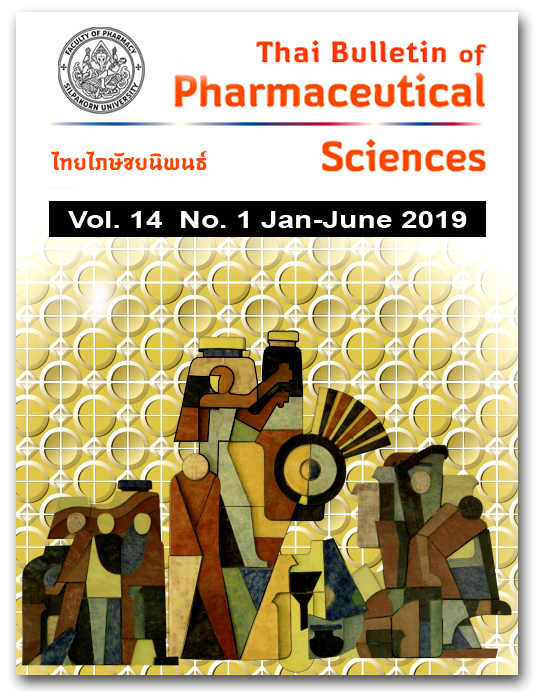EVALUATION OF MEASURE IMPLEMENTATION OF INAPPROPRIATE DRUG USE SELLING REPORT
DOI:
https://doi.org/10.69598/tbps.14.1.65-78Keywords:
evaluation, drug use selling report measure, medicine listed in the measure, inappropriate drug use problemAbstract
An Implementation of the measure for inappropriate drug use that requires drugstore licensees to fill drug buyer’s names in drug control selling forms may affect related stakeholders. This study therefore aimed to evaluate the measure by surveying the opinions of drug buyers and providers toward the measure via mail from April 1 to July 15, 2016. A Stakeholder focus group meeting was also scheduled in August 26, 2016. The survey results show that most customers (43.0%) bought the medicine listed in the measure as advised by drugstore owners. 74.8% of respondents realized inappropriate drug use, specifically Tramadol. Most channels that the respondents recognized are social media and community pharmacists. In addition, 82.5% of customers who reported their names when buying drugs listed in the measure knew that a drugstore needed their names to fill in a drug control selling form. The study samples believed that this measure caused complicated steps in medicine purchasing, which resulted in lowering their satisfaction. From the viewpoint of drugstore workers, a drugstore played a vital role in decreasing inappropriate drug use problems however only this measure was not sufficient to solve all the problems. Moreover, this measure consumed more service time because drugstore owners had to give a reason why they had to require drug buyer’s names. Drug expenditure time also increased due to this measure. The results from stakeholder’s focus group demonstrated that this measure could not fulfill the objectives due to a lack of controlling every step of the drug distribution system, especially drug manufacturing, importing, and online selling. Additionally, the drug listed in the measure should be reviewed. In conclusion, Food and Drug Administration as the measure implementation organization should provide public relations regarding the measure to people and all stakeholders for more understanding by means of all communication channels. The list of medicines in the measure should be reviewed. The use of other measures to reduce inappropriate drug use problems is also highly recommended.
References
2. Chardsumon P. Policy and Strategy on Illicit Drugs' Prevention and Suppression. Addiction Knowledge Management Project. Nonthaburi: Health System Research Institute; 2008.
3. Sutheravut P, Hongchayangkool K, Charoensawat Y, Uyob N, Rodkantuk N, Khunchan S, et al. Drug abuse surveillance in adolescents: case study in southern border provinces. Health System Management Institute, Prince of Songkla University; 2013.
4. Food and Drug Administration Announcement about rules, procedures and conditions of Drug selling. Government Gazette book number 132 special section 179 D August 4, 2015 p. 13.
5. The Pharmacy Council of Thailand: The pharmacy professional standard in pharmaceutical care. [cited 2016 July 20]. Available from https://www.pharmacycouncil.org /share/file/file_260.pdf.
6. Ministerial regulations: The permission and licensing of drug B.E. 2556. Government Gazette 2013; 130(126 Kor, Dec 27,2013:1)
7. United Nations Office on Drugs and Crime, World Drug Report 2014 [Online].n.d. [cited 2016 Jul 20]; Available from: https://www.unodc.org/documents/data-and-analysis/ WDR2014/World_Drug_Report_2014_web.pdf.
8. Herzberg D, Guarino H, Mateu-Gelabert P, Bennett AS. Recurring Epidemics of Pharmaceutical Drug Abuse inAmerica: Time for an All-Drug Strategy. Am J Public Health.2016;106(3):408-10.
9. Nasira S., Rosenthala D., Moore T. The social context of controlled drug use amongst young people in a slum area in Makassar, Indonesia. Int J Drug Policy. 2011;22:463–70.
10. Freeman PR, Talbert J, Blumenschein K. Impact of prescription monitoring programs on controlled Substance prescribing behavior. Value Health. 2011;14:A27.
11. Manager online: Best sales “Procodyl” incresing death syrup to “aldolescent”. [cited 2016 July 20]. Available from https://mgronline.com/live/detail/9590000072141.
Downloads
Published
How to Cite
Issue
Section
License
All articles published and information contained in this journal such as text, graphics, logos and images is copyrighted by and proprietary to the Thai Bulletin of Pharmaceutical Sciences, and may not be reproduced in whole or in part by persons, organizations, or corporations other than the Thai Bulletin of Pharmaceutical Sciences and the authors without prior written permission.



